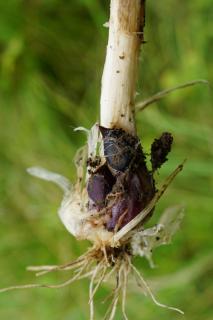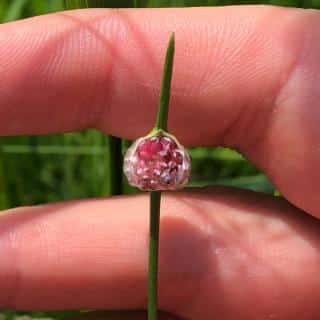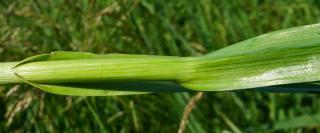

Rocambole garlic is named after a fictitious character with an extravagantly nutty behavior. Rightly so! This garlic grows its cloves at the tip of its stems!
Rocambole quick facts
Botanical name – Allium scorodoprasum
Common name – Rocambole garlic, sand leek
Family – Alliaceae
Type – bulb vegetable
Height – 4 to 20 inches (10 to 50cm)
Planting distance – 4 to 6 inches (10 to 15 cm)
Exposure – full sun
Soil – All kinds of soil, as long as soft, deep and well-draining
Planting – Fall, end of Winter
Harvest – Summer
Rocambole, or sand leek, is doubly of interest for the vegetable patch: of course it has the bulbs with cloves typical of garlic, but on top of that – at the very tip, actually – it has small secondary bulbs at the end of each stem! Both very tasty and hardy, it’s worth dedicating a portion of the growing bed to.
This bulb vegetable loves reaching for the sky in full sun, where it truly thrives. It isn’t very picky concerning the soil, and can cope with a wide range of pH and soil types. Nonetheless, an important factor is that the soil must be soft and, preferably, full of organic matter.
To raise your chances of success and increase the harvest, here are a few recommended preliminary steps. First of all, never add rich organic material (soil mix, compost, manure) to the soil just before planting. It’s best to have done it a full year ahead to stave off any risk of rot and diseases. One good way to do this is to choose for your rocambole garlic a spot that has been abundantly amended and enriched for cultivation the previous year.
To loosen up the structure of the soil, it’s enough to break it up 4 to 8 inches deep (10 to 20 cm) with a broad pitchfork (broadfork) or grelinette, for instance.
 The planting takes place in October-November or in February. It’s done in a few quick steps:
The planting takes place in October-November or in February. It’s done in a few quick steps:
You can also directly use the secondary bulblets that appear at the tip of the top-setting garlic, but it takes longer because the plant needs a full year to establish a bulb of cloves.
And remember its more down-to-earth name: sand leek. This means it loves drainage! Make sure you don’t plant it in a soggy part of the garden or you’ll be disappointed…
 Sand leek requires practically no attention at all once it has settled in comfortably. This hardy species adapts well to temperature swings and doesn’t require any watering. Nonetheless, you might want to water a bit during unordinarily long dry spells, but refrain from doing this before the harvest.
Sand leek requires practically no attention at all once it has settled in comfortably. This hardy species adapts well to temperature swings and doesn’t require any watering. Nonetheless, you might want to water a bit during unordinarily long dry spells, but refrain from doing this before the harvest.
Hardy, we’ve mentioned, but also very resistant, Allium scorodoprasum isn’t vulnerable to diseases. As an added advantage, pests and parasites seem to disregard this plant altogether.
You can harvest your rocambole garlic in August, in two steps:
Rocambole garlic has the capacity to keep for a long time. All you need to make sure of is that it’s stored in a dry and well-ventilated spot. Spread it out in trays or hang it in clumps from a beam.
 Garlic in general is a condiment that enters into many different recipes, and rocambole is no exception. You can use them in exactly the same manner as you would its cousin, and add it to all the same recipes. They’ll feel a bit richer and deeper because rocambole garlic has a more pungent taste. Eating the bulblets is also an option, since they’re edible, too. Just like pearl onions, you can pickle them in vinegar or dice them up and toss them into a mixed salad. Rocambole garlic is definitely a candidate of choice for unique and original gourmet experiences!
Garlic in general is a condiment that enters into many different recipes, and rocambole is no exception. You can use them in exactly the same manner as you would its cousin, and add it to all the same recipes. They’ll feel a bit richer and deeper because rocambole garlic has a more pungent taste. Eating the bulblets is also an option, since they’re edible, too. Just like pearl onions, you can pickle them in vinegar or dice them up and toss them into a mixed salad. Rocambole garlic is definitely a candidate of choice for unique and original gourmet experiences!
This is a great choice for the garden: children will be thrilled at seeing the tiny flowers sprout new tiny plants!